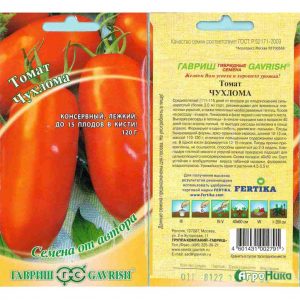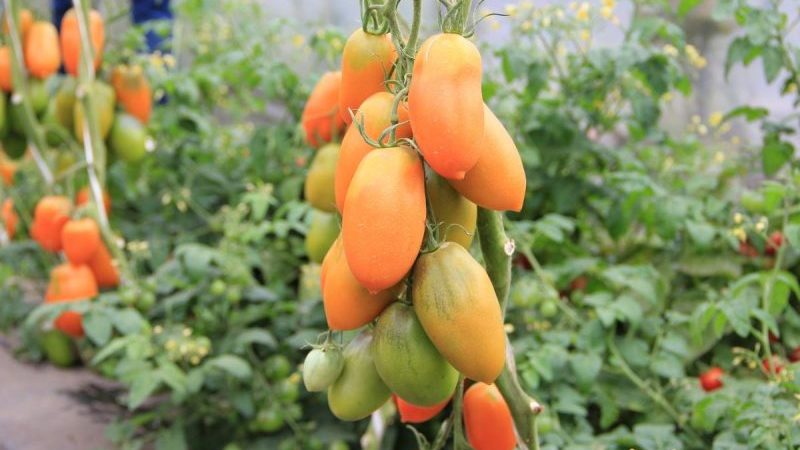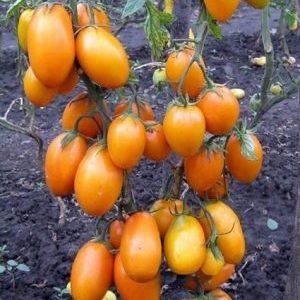Tall and harvestable tomato "Chukhloma": grow on our own and enjoy the fruits
Tomatoes are popular vegetables, and therefore are found in almost every garden. New varieties appear every year, some of which immediately gain popularity. Among them are bright and beautiful tomatoes of the Chukhloma variety. Its original fruits will decorate the summer cottage and diversify many dishes.
The content of the article
Description of the variety
The Chukhloma tomato was bred in 2004 by the Gavrish agricultural company and belongs to indeterminate plants.
Mid-season variety: 110-115 days pass from sowing to the appearance of the first fruits. The height of the main stem is 2 m or more. The first flowers are formed over 9 leaves, the rest - every 3 leaves. Up to 15 fruits are tied on each hand.
Distinctive features

The peculiarity of the Chukhloma variety is its appearance. Large bushes, hung with garlands of pepper-shaped tomatoes of varying ripeness: from light green to bright orange. The taste of ripe fruits is sweet and delicate.
Fruit characteristics and yield
Elongated oval tomatoes are bright orange in color without darkening at the stalk. The skin is firm with a slight waxy bloom. Vegetables do not crack during transportation. For a month, they retain their presentation and taste, so the variety is often grown for sale.
Subject to the rules of agricultural technology, up to 6 kg of crop are harvested from one bush. Fruit weight - 150 g. Chukhloma tolerates unfavorable climatic conditions, but in regions with a cool climate it is grown in greenhouses or under a film shelter.
How to grow seedlings
The variety bears fruit both in open and closed ground, but the crop gives the maximum yield in greenhouse conditions.
Seedlings are grown for 45-50 days, not 2 months, as in other varieties:
- On March 15, the seeds are disinfected and germinated;
- Sowing is carried out on March 20;
- Shoots appear on March 25;
- On May 10, the plants dive to a permanent place.
On a note! With this scheme, the first fruits will ripen at the end of July.
Seed preparation
Chukhloma is a variety, not a hybrid, so some summer residents collect seeds from their own harvest. In this case, the grains must be disinfected.
The planting material is etched for 20-30 minutes in a 1% solution of potassium permanganate. Then they are washed under running water and germinated in a damp cotton cloth until sprouts appear. The fabric is periodically moistened, but not overmoistened: this will lead to rotting of the seeds. The procedure takes 3-4 days.
For your information! Purchased branded seeds are disinfected by the manufacturer, so they are only germinated.
Capacity and soil
Seedlings are grown in such containers:
- peat tablets or cups;
- containers with cells and a lid;
- wooden boxes;
- disposable cups;
- cut plastic bottles or milk cartons, juice.
When the seeds are hatched, soil preparation begins. To do this, mix 2 parts of peat and 1 part of sand. For 10 liters of the resulting substrate add 1 liter of wood ash.
Sowing
For more convenient cultivation of crops, peat tablets are used. They are placed in a plastic container and moistened. When they increase in volume, they plant seeds and wrap the container with foil to create greenhouse conditions. Once a day, the container is ventilated. When the roots appear from the cylinder, the tomatoes dive into separate containers.
The sowing itself is carried out at a distance of 2 cm from each other and 3 cm between the rows. Planting depth - 1 cm.
Growing and care
The treatment includes three main procedures:
- soil moisture;
- turns of plants towards the light so that the shoots do not twist;
- fertilization.
Diving of tomatoes is carried out in large containers, while the stems are deepened to the cotyledonous leaves. During the seedling period, this is done 1-2 times.
Tomatoes are fed:
- Agricola;
- "Athlete";
- nitroammophos.
Some vegetable growers use folk remedies as fertilizers:
- Ash extraction... 80 g of wood ash is added to 5 liters of water. For 24 hours the mixture is infused and then filtered. The solution is moistened with the soil and sprayed on the leaves.
- Yeast... To prepare the nutrient mixture, a yeast briquette (10 g) is stirred in 10 liters of water. After daily infusion, the seedlings are watered with a solution. The tool is not stored, but used immediately.
How to grow tomatoes

Plants are planted in a sunny, windless area with moderately moist soil. The soil should be light and soddy and low in acidity. The garden has been dug up since autumn. Chukhloma has a strong immunity to diseases, however, for prevention, before planting, the soil is treated with a weak solution of potassium permanganate.
Landing
4 plants are planted per 1 m2. The planting pattern is 60x40 or 70x35 cm. A small layer of humus and superphosphate or ash is added to the bottom of the holes.
Since the variety is tall, a support is immediately installed. To do this, use a trellis with a coarse mesh or drive wooden stakes into the ground.
Care
Tomatoes are looked after as follows:
- Since the variety is tall, the plants tie up to the support. This will preserve the health and shape of the culture.

- Every week get rid of stepsons, the length of which has reached 5-6 cm. So the nutrients will go to the development of fruits, and not green mass.
- In order for the bush to be powerful, 1 central stem is left, and for high yields, the plant is formed into 2 trunks.
- Tomatoes are watered once a week, but if it's worth heat - 2 times;
- The soil is regularly loosened and weeds are removed after watering the plants.
In order for tomatoes to develop well, they are fertilized on time. Nutrients are introduced at the stages of flowering and fruit formation:
- A few days before flowering, tomatoes are fertilized with a mullein solution (4 kg per bucket of water).
- A week after the inflorescences have fallen off, the plants are fed with superphosphate (400 g per 10 l of water).
- To improve the taste of vegetables, during the period of fruit formation, the culture is fertilized with a solution of ammonium nitrate (30 g per 10 l of water). For 1 bush, 5 liters of the mixture are used.
Regardless of the chosen planting site, mulching is carried out to retain moisture in the soil.
Vegetable growers do not have any particular difficulties in growing a variety.
Diseases and pests
The Chukhloma tomato is resistant to diseases and pests, but due to improper care or exposure to external factors, there is still a small risk of disease. To preserve the harvest, the bushes are regularly examined for diseases and pests.
The most common diseases and pests:
- Fusarium tomato wilting - fungal pathology. The bushes look like they lack moisture: the lower leaves turn yellow, and the stem cracks and becomes covered with a black crust. So that the plants do not get sick, the rules of crop rotation are observed. If the culture is already affected, special preparations are used: "Trichodermin" or "Previkur".
- Gray rot. It affects the culture in greenhouse conditions. The disease destroys the leaves and stems, spreads to the vegetables themselves. Dark spots with a grayish tint are removed by airing the structure.
- Late blight... First, the leaves dry out and turn yellow, then the fruits suffer. The reason is excessive moisture. So that the plants do not get sick, the rules of crop rotation and the irrigation regime are observed. For treatment, use means "Tattu", "Kwardis" or "Mikosan".
- Rolling the leaves... A fungal disease that affects the culture at different stages of development.Control measures - timely feeding with the necessary trace elements.
- Whitefly - white midge, which is localized on the back of the leaves. Appears when growing tomatoes in a greenhouse. Eliminate the pest by airing structures, using insecticides.
- Spider mite - a small arachnid that spoils the leaves of the culture. If measures are not taken in a timely manner, the vegetation becomes covered with yellow spots and dies. They get rid of the pest with biological products: for example, "Aktofita".
- Aphid - an insect that destroys vegetables in the greenhouse and in the open field. Destroy it with folk remedies (dust, ash, herbal decoctions) or insecticides.
To reduce the risk of crop disease, the rules of watering and crop rotation are observed, and fertilizing is correctly applied.
The nuances of growing in an open field and a greenhouse
The Chukhloma tomato is grown throughout Russia. The variety bears fruit both in greenhouses and in the open field, but only in regions with a warm climate.
In greenhouses, take care of regular ventilation. In the open field, during the first weeks of ripening, use film covers.
Harvesting and application of the crop
Tomatoes are harvested as they ripen. The fruits of Chukhloma are so beautiful that it is a pleasure to collect them.
On a note! Plucked tomatoes have a longer shelf life.
Vegetables are universal in use: they make delicious and aromatic salads, pickled snacks. When cooked, tomatoes retain their taste. The fruits are added to sauces, pastes, juices.
Advantages and disadvantages of the variety

The main advantages of Chukhloma:
- high productivity;
- excellent taste and aroma of vegetables;
- long-term fruiting;
- strong immunity to disease;
- versatility in application;
- good transportability;
- long-term storage;
- the ability to collect seeds from your own harvest.
There are also disadvantages:
- the plant needs a garter to support;
- culture must be pinned;
- the fruit has a weak juiciness.
Farmers reviews
The Chukhloma tomato is cultivated in almost any climatic conditions, in open and closed ground. The variety has more advantages than disadvantages, which is why vegetable growers prefer it.
Elena, Perm: «Last year I grew the Chukhloma variety. The bushes are high, up to 2.5 m. The plant has many clusters, similar to clusters, each with up to 10 tomatoes. The fruits are slightly dry, if they overripe, voids appear inside. It tastes sweet. Oblong vegetables - I put them in a jar while standing, but they do not crack. The rind is firm but not rough. Tomatoes look great in a jar. I liked this kind of culture. Next time I will plant more. I advise everyone!".
Olga, Kirov: “Before that, my mother had always grown the Chukhloma tomato. That year I tried to plant it too. The variety is quite fruitful and does not require special attention. The bushes do not get sick and are not affected by pests. Plants formed into 1 stem. The taste of tomatoes is excellent, but I like salting more, and they look wonderful. Moreover, culture does not cause allergies, which is important in our family. ”
Vasily, Tyumen: "In a gardening store, the seller advised me to buy Chukhloma tomato seeds. I liked the photo on the package right away. He grew tomatoes in the open field. I didn't like this variety. One vegetable weighed about 80–100 g. The taste was medium, neither sour nor sweet. I will look for new varieties for myself. "
Conclusion
The Chukhloma tomato is grown both in greenhouses and in the open field. The plant gives a bountiful harvest (up to 6 kg of unusual fruits from 1 bush). The variety is resistant to major diseases, which makes it much easier to care for.
Long-term storage and high transportability without losing the presentation and taste of tomatoes allow you to grow crops for sale.